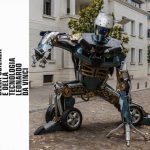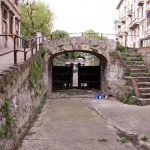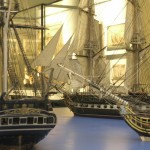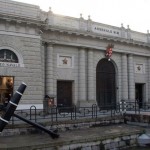Milan, Museum of Science and Technology, from March 3rd to May 1st
Milan: Museum of Science and Technology
Dedicated to Lenoardo da Vinci’s discoveries, studies and models
The National Museum of Science and Technology of Milan is called Leonardo Da Vinci and there are many rooms dedicated to his discoveries, studies and models that paved the way for subsequent technology and research.
Let’s have a tour looking for some of the maestro‘s ingenious ideas, then we visit the museum’s department dedicated to space.
Please note that the museum setup you see in this video dates back to 2016 and does not correspond to the current one (November 2023)
⇒ Watch the full web serie Milan & Leonardo da Vinci
Visit the Museum official website
Visit Turismo Milano official website
Video full text: The Museum of Science
The National Museum of Science and Technology.
What’s it called? Leonardo da Vinci!
There are rooms here that are dedicated to all his discoveries, studies and models
that paved the way for subsequent technology,
from great trains to aircraft and catamarans,
everything that he ever thought about and that subsequently became reality.
Science is culture.
We all probably carry a bit of Leonardo’s intelligence within us.
Come to think of it, even the Milanese, who are so capable of reinventing themselves and using technology.
In effect, this is a little of how their spirit is.
The head of the presumed old Leonardo is inserted into the neck of a young woman.
Then there’s Galilei or Einstein, inserted into a normal man
who is holding the famous E = mc2 formula in his hand. What a beautiful formula!
Then there’s Darwin, with a beard loaned by another bearded gentleman.
In the centre of the museum there is an operating turbine,
that came from an electricity generating station in Como that was opened in 1895.
It’s magnificent!
It’s just like the one in Charlie Chaplin’s Modern Times.
The National Museum of Science and Technology has a bit of everything.
A hangar containing complete operating trains, a submarine, old sailing ships,and a merry-go-round in the courtyard that in reality is a Chinese work of art.
This Chinese artist travelled across the countryside of China’s nine provinces
looking for the productions of simple peasants who built these objects.
He was so struck by these things that he collected these objects,
and put them all together in order to tell others about the intelligence applied by these people to the simplest of things.
From the tiny models of Chinese peasants to the models made from drawings by Leonardo Da Vinci.
Claudio shows me some of the maestro’s ingenious ideas.
No matter the technological advance, Leonardo had already thought about it!
The propeller: a great base that, as he said, would climb into the air if rotated quickly.
It was simply a question of waiting for human technology to reach the right moment.
It would rise up but only when electricity and steam arrived!
His intuition was correct, but he was way ahead of the times.
He also put his intelligence to work in the world of fabrics,
essential both in Florence and Milan, where silk was manufactured.
How to weave cotton, silk and all these materials?
With a mechanical loom!
It wasn’t until the end of the 19h century that his invention was used on an industrial loom.
The world of fabrics, clothing and fashion and therefore Milan!
Leonardo was also the father of this, Milan’s most important feature.
He was right: it can be done.
If nowadays people throw themselves around the sky in gliders and hang-gliders,
it is because Leonardo came up with the idea.
This is one of Leonardo’s last drawings in relation to flight,
where he began to come up with a very simple shape:
starting from scratch, the idea was not to try and lift a bird off the ground, but to take advantage of the currents.
He did a lot of research and even wrote a book dedicated to the study of how air interacts with birds.
The “Codex on the Flight of Birds” is now kept in Turin.
In Florence he even tried to make one his assistants fly, but Tommaso Masini ended up getting hurt!
Leonardo gave up on the idea,
conscious of the fact that all the right materials were still not available,
and that it was not possible to have all these assistants!
It wasn’t until centuries later, right at the end of the 19th century,
that someone independently developed this idea.
To fly, with this example of a glider and then on, into space.
The museum’s department dedicated to space has a fragment of the moon donated to friendly countries by the Americans in the wake of the Apollo 17 mission.
I think it will be the only piece of the moon they’ll give us, but at least we do have a fragment!
Leonardo’s spirit would probably come here to see these sorts of basins
that have travelled into space and even back again!
It’s incredible! Space exploration bears little resemblance to the film “2001: A Space Odyssey”,
where everything is antiseptically perfect.
It’s more like “saucepans in space!”
His mechanical enterprise, that sometimes appears so complex, is such a basic endeavour,
and it is not much different from man’s attempt to go to the moon or fly into space.
Essentially we are going there with technologically advanced “saucepans”,
but they are still, nevertheless, “saucepans” in the infinity of space!
This is what the astronauts see from their space station.
Here’s Italy, the world we live in.
If only Leonardo could see it and take this flight!
We Italians are actively involved in space missions,
Italian astrophysicists have always been at the cutting edge.
Italy is the third nation in the world to have launched a satellite into space,
the San Marco satellite.
Satellites are scrutinising us, spying on us and photographing us from up there.
We tell them everything with our phone calls.
Everything we say is recorded and stored away somewhere.
So if one day we need to be checked out by someone,
they’ll be able to look at everything we’ve ever said during the last five years!
In our case they wouldn’t come across anything incredible,
but it depends on who is being listened to!
Then there are the earth observation satellites:
photographing the earth from space helps to understand so many things.
For example for hydrogeological reasons,
or to monitor how the growth of cities might change an area.
Another very important thing is water.
Ours is a planet made up of water, of which only 3% is available for consumption.
It is therefore a very precious resource.
Observation from space helps us to monitor the situation,
when it is possible to intervene, or be mindful of these phenomena.
What is striking, for instance, is the image of the border between the Palestinian State and Israel.
On the one side there is greater development, more technology and resources and a different economy.
This is the path for our planet’s future.
Greater rationality in the use of an area, in this case for agricultural use,
reduced loss of water,
higher levels of production and greater output per square hectare in the area.
We have seen the cities, now these are the forests,
our store of oxygen!
Leonardo would also have liked this a lot!
Visit Milan: helpful hints
Italian name: Milano
Arrival
Milan has got three airports:
- Malpensa Airport is the largest international & intecontinental Airport in Northern Italy. 30 miles Northwest from the city centre. Connections:
→ Train Malpensa Express: trains leaves every 30 minutes in each direction, connecting the Airport to Milan Grand Central Station or Cadorna Railway Station. Terminals 1 and 2. It takes 45 min, price: 14 €
→ Shuttle Bus: Malpensa Shuttle and Malpensa Bus Express connect the airport to Milan Grand Central Railway Station and Milan’s Underground Network. Terminals 1 and 2. It takes 60/70 min, price: 8 € - City Airport Linate is an international airport connecting Milan with main European cities, located just 4 miles from the city centre. Connections by shuttle: Atm Bus n. 73 from Milano Duomo M1 – M3 (Piazza Diaz, direction: San Babila), first ride at 5.35 am, last one at 00.35. Frequency: every 10 min, price 1,5 €
- Milan Bergamo Airport Orio al Serio is mainly low cost flights Airport, located 30 miles Northwest from Milan. Connections only by Shuttle: There are 4 different bus companies, pricing changes from 5 up to 8 €
Transports
ATM is Milan public transport service both for bus, tram and subway. Single ticket costs 1.50€ for 90-min ride. Consider daily/weekly subscriptions. You can buy tickets also texting to 48444. Milan Subway is the longest in Italy, covering 95 km: Donwload and check the map.
Moving in town can be nice also by bike: Milan has got a powerfull bike sharing service providing both regular and e-bikes. Here is the experience of our Ambassador Kim Harding with BikeMi service and a useful video of our Ambassador Roxana explaining how does it work. Car Sharing is also good with many different companies to choose.
Try also the local urban railway train, called Passante Ferroviario, check the experience of our Ambassador Roxana Iacoban travelling by local train in town.
What to do in Milan
Milan is the Italian financial center and one of the European capitals of Fashion. Known for its nightlife as well.
Some tips on Italia Slow Tour: watch our web serie about Leonardo da Vinci’s places, climb on top of the Duomo, visit Prada Foundation, Museums and Art Galleries, taste some fine gelato and try the local Aperitivo and – not joking – enjoy a sailing trip (!!) or some time deep in the nature close to some actual farms and fields.
Where to sleep
Accomodations are quite expensive in Milan, fares rise up and hotels get full according to the rich event calendar of the city (see: Fashion Week, Salone del mobile, Big concerts, Theatre and Sport events, etc.). If you are not specifically interested in any of those, try to travel during other periods to save some money.
Italia Slow Tour recommends:
- Hotel Cervo in Garibaldi District if you want to stay close to city centre and enjoy the nightlife
- Hotel Concorde located on the Green Way Milan-Lecco to Lake Como, if you want to move around adn travel by bike
Shopping in Milan
The famous Fashion District involves the following streets/areas: Via Montenapoleone, via Manzoni, via della Spiga and Corso Venezia. The so called “Quadrilateral of Fashion”. Here you can find all kind of brands and shops. Easy to reach by Subway (stop at Montenapoleone station).
Don’t miss the Street Markets! Almost every day you can find one: best are the ones in Viale Papiniano (on Tuesday) and Via Fauchè (on Saturday). More on the official website of weekly street markets. If you are into sustainable local products, Milan has got 8 actual farms in town and a green Earth Market.
If you are interested in Outlet Shopping, in the outskirt of Milan you can find 4 different Fashion Outlets, in a radius of 62 miles. Here you can find everyday a lot of famous high quality Italian brands on sale, with prices cut off up to 50%. All the outlets are connected to the center of Milan by Shuttle Bus:
- Serravalle Designer Outlet – Shuttle departure from Milan Central Station or Cairoli square
- Fidenza Village Outlet Shopping – Shuttle departure from Piazza della Repubblica 5, at the corner with Turati st.
- Vicolungo The Style Outlets – Shuttle departure from Cairoli square
- Rodengo-Saiano Franciacorta Outlet Village – Shuttle departure from Cairoli square















1 Comment
Il mio Slow Tour a Milano | Nomadizziamoci
[…] Il Museo Nazionale della Scienza e della Tecnologia Leonardo da Vinci […]